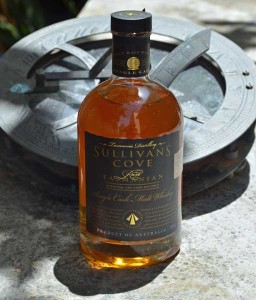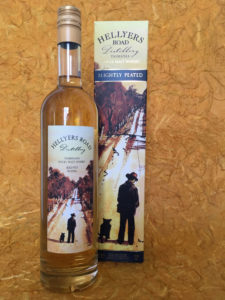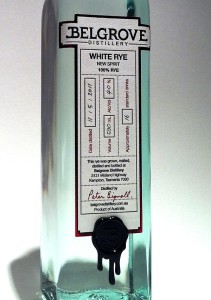Don’t Call Tasmania A Whisky Newcomer, Because They’ve Been Making It For A Generation
By Richard Thomas
In Tasmania, Lady Jane Franklin is known as one of the Australian island’s pioneers. However, she was also an enthusiastic supporter of the Temperance movement, famously declaring in 1838 that she “would prefer barley be fed to the swine than used to turn men into swine.” She persuaded her husband, the governor of Tasmania, to outlaw the 16 legal distilleries on the island.
It wasn’t until Bill Lark observed Tasmania had good conditions for Scotch-style whisky-making and found Franklin’s Temperance laws still on the books that things began to change, and in 1991 whisky distillation was legalized throughout Australia. Lark and his wife promptly opened their own distillery on the island, and it’s still in operation today.
The country now hosts almost two dozen active distilleries, many of them opened immediately following legalization. Yet the conditions that made Tasmania ideal for making malt whisky almost 80 years ago are still there today, and it’s Tasmanian malt whiskies that are garnering nearly all the international attention that goes to Australia.
Today Tasmania supports 11 distilleries that have released at least one whisky to date, with a few more are in the pipeline, and there is even an official Tasmanian Whisky Trail to encourage tourism. All that is really missing to name Tasmania one of the world’s major whisky-making regions is a big, mass market brand, because the industry has certainly surpassed that of older, second-tier countries in Europe.
The Boomers
Lark Distillery
The house of the man who was instrumental in starting it all, Lark began operations in 1992 and has released a long succession of single cask, single malt whiskies. The last such release I saw information on was a Port wood cask-matured malt from a cask numbered 450. This was in a 70 cl bottle, but many earlier releases were in 50 cl bottles. A Lark whisky labeled as a small Port cask, cask strength single malt managed to find its way to the United States a couple of years ago, but more Lark bottling are rarely seen outside of Australia, Singapore and Europe.
Sullivans Cove
By winning a World’s Best Single Malt at the 2014 World Whisky Awards for its French Oak single cask, Sullivans Cove put Australian whisky on the map. The followed that up in 2015 by releasing the most expensive Australian whisky ever (based, predictably, on the award-winning French Oak single cask), and at the end of 2016 owner Patrick Maguire sold the distillery to a Melbourne-based investment group led by Australian and former Bladnoch manager Adam Sable.
Hellyers Road
Lark is a big presence in Tasmanian whisky because it’s namesake and founder helped open the doors, and Sullivans Cove is the big international medal winner. Yet when I lived in Europe and went to trade shows there, more often than not the Australian presence in the convention hall was Hellyers Road, making them the region’s third big name in my mind.
Although not one of the oldest distilleries on Tasmania, Hellyers Road has developed the broadest and deepest line of any distillery on the island. These include 14, 12 and 10 year old expressions, as well as NAS single malts, of both peated and unpeated whiskies and a variety of cask finishes.
The Cockies And Tin Lids
Several other distilleries on Tasmania either have released at least one whisky, and although these are not as well known, some are making whiskies to match their more renowned rivals. Some are fairly new, while others are as old or older than even Lark, and a few are just downright quirky.
Belgrove Distillery
Two things set Peter Bignell’s Belgrove apart from the other Tasmanian distilleries. First, it’s a true farm distillery, founded in 2008 on an already working farm. All the grain used is grown there, and Bignell made his copper pot still himself. Second, Belgrove is the only distillery making rye whisky in Australia.
Cradle Mountain
Originally known as the Darwin Distillery, this outfit quietly began operations in 1989, prior to legalization. Springbank’s independent bottling arm William Cadenheads liked their early work so much that they ordered several barrels in the mid-1990s.
Cradle Mountain’s output is small, and batches tend to sell out quickly. Also, just as the company got started by quietly fine-tuning their process before legalization, they have also quietly laid away some stock and allowed it to age to proper Scotch-like proportions. The only product listed as available at the time of publication was a 17 year old single malt, and Cradle Mountain has plans to release a 20 and 21 year old in the near future.
Heartwood Malt Whisky
They began operations in 1999 and are on the verge of releasing a 17 year old single malt. Heartwood’s whiskies consist of a series of limited releases, each one unique and never to be seen again. At the time of publication, they had three whiskies in stock, and these serve as good examples of what Heartwood does as anything: a pair of Sherry cask-aged, peated, single cask and cask strength 8 year old malts and an 11 year old cask strength aged in a second fill Port pipe and finished in two Sherry casks.
McHenry Distillery
This nano-distillery (the still house has the look of a two-room cabin) follows the tried and true path of making gin and vodka, in addition to a whisky. Their uphill location and proximity to the sea is said to impart a tinge of sea spray/iodine to their Three Capes whisky.
Nant Distillery
Named for the historic estate hosting it, Nant Distillery came into being in 2004, following the purchase of said namesake property by the Batt family. It’s single malts have come to be highly regarded by experts in recent years. The core series consists of four malts, each aged in a different wood: Sherry, Port, Pinot Noir and Bourbon. On top of this are a string of single cask and cask strength limited releases.
Old Hobart Distillery
The makers of Overeem Whisky, this distillery first fired up the stills in 2007. Their product line is based on a wood theme, with whiskies aged in Sherry butts, Port pipes and bourbon barrels. Each wood type has a pair of expressions, one bottled at regular strength and a cask strength version, for a total of six different single malts.
Redlands Distillery
Like some American small distillers, Redlands offers its own distillery school, allowing enthusiasts and potential entrepreneurs alike to learn the ins and outs of running a boutique distillery. Their most recent single malt release, a 2 1/2 year old (not quite up to the minimum Scotch whisky standard of three years), is sold out, but more is coming.
Shene Distillery
Shene claims to have the largest pot still in use in Tasmania, made by the local master stillmaker/coppersmith. They have used this to make a triple distilled, Irish style single malt whisky, and have made two single cask releases thus far. A third is forthcoming. All the casks are made from Port wood, but not in the form of Port pipes. The distillery instead specifies them as 100 and 20 liter casks, and since 100 liters is half the size of an American Standard Barrel (ASB).
Sourced Whiskies
Tasmanian has even developed a sourced and independently bottled brand of its very own, Trapper’s Hut. The folks behind this whisky managed to acquire several ASBs of Sullivan’s Cove whisky, and made their first single cask, single malt release in 2008. Several have followed since then, with the age statement gradually rising. The existence of 15 year old Trapper’s Hut has been confirmed, and the next release should be even older.
 The Whiskey Reviewer A World of Whiskey, Poured Every Weekday
The Whiskey Reviewer A World of Whiskey, Poured Every Weekday



